![The author and Sokhom on top of the world, at Preah Vihear [Jan 2005]](http://andybrouwer.co.uk/2005e.jpg)
ANDYBROUWER.CO.UK
CAMBODIA TALES 2005 - JANUARY
Preah Vihear - on top of the world
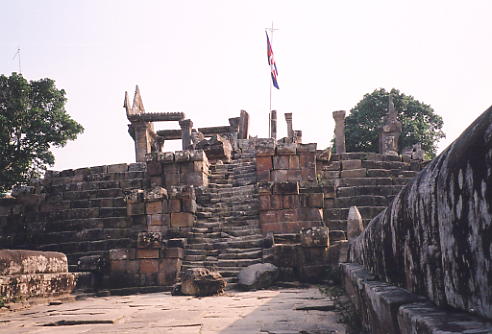 Leaving the village of Siyong at 7.30am, following
our visit to the Koh Ker complex of temples, our aim was to reach
Prasat Preah Vihear, on the border with Thailand, as soon as
possible. I wanted to stay overnight at the temple complex, which
has the most dramatic location of any of the Khmer temples,
sitting on the edge of the Dangrek mountain range, which serves
as the natural border between the two countries. The road from
Siyong to Kulen was initially a forest track until we came upon a
massive
Leaving the village of Siyong at 7.30am, following
our visit to the Koh Ker complex of temples, our aim was to reach
Prasat Preah Vihear, on the border with Thailand, as soon as
possible. I wanted to stay overnight at the temple complex, which
has the most dramatic location of any of the Khmer temples,
sitting on the edge of the Dangrek mountain range, which serves
as the natural border between the two countries. The road from
Siyong to Kulen was initially a forest track until we came upon a
massive 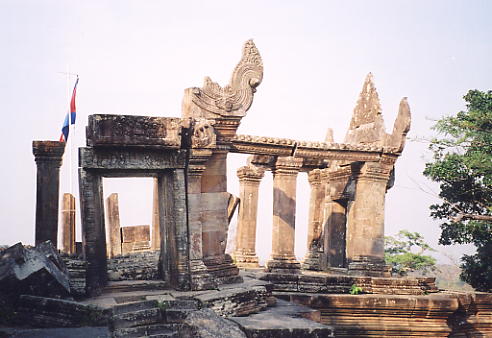 road-building project, scorching an area through the
forest wide enough to accommodate a four-lane highway. The
earth-diggers and trucks were working in tandem to complete the
road from Tbeng Meanchey to Koh Ker in double-quick time. The
temporary earth and sandy surface was hard work for Sokhom's moto
and I had to walk at times, which some of the road-crew found
amusing, as we took an hour to reach Kulen village, where the
broken bridges of previous trips had been fixed and the road was
smooth and firm. Thirty minutes later, we stopped briefly at
Thnal Bek for food and water, as we joined the road heading
northwards towards Preah Vihear. This was the new government road
built a couple of years earlier which was excellent in places and
atrocious in others.
road-building project, scorching an area through the
forest wide enough to accommodate a four-lane highway. The
earth-diggers and trucks were working in tandem to complete the
road from Tbeng Meanchey to Koh Ker in double-quick time. The
temporary earth and sandy surface was hard work for Sokhom's moto
and I had to walk at times, which some of the road-crew found
amusing, as we took an hour to reach Kulen village, where the
broken bridges of previous trips had been fixed and the road was
smooth and firm. Thirty minutes later, we stopped briefly at
Thnal Bek for food and water, as we joined the road heading
northwards towards Preah Vihear. This was the new government road
built a couple of years earlier which was excellent in places and
atrocious in others.
As
well as heading for Preah Vihear, I'd also harboured thoughts of
searching around the village of Yeang on the hunt for more remote
temples and at 10.30am we reached the turn-off for the village
some 20kms northwest. However, the route into the forest looked
no better than an oxcart trail and in all probability, 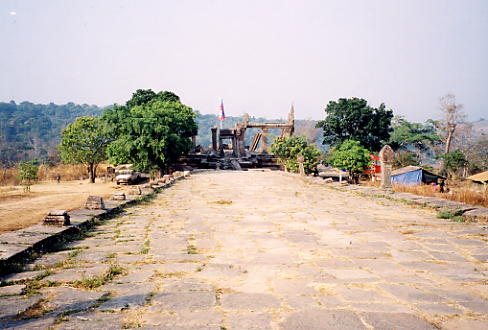 landmines would present a hurdle to my search, so I
decided to leave it for another day and we carried onto towards
our main goal. The road had deteriorated badly in places and was
so poor that our moto even overtook a 4WD, the only other vehicle
we'd seen since Thnal Bek. At mid-day we encountered two motos
and their passengers on the roadside looking rather forlorn and
stopped to offer assistance. Beth and Scott, a couple from
London, were travelling from Tbeng Meanchey to Preah Vihear with
two moto-drivers but had a flat tyre, so Sokhom came to the
rescue with a replacement
landmines would present a hurdle to my search, so I
decided to leave it for another day and we carried onto towards
our main goal. The road had deteriorated badly in places and was
so poor that our moto even overtook a 4WD, the only other vehicle
we'd seen since Thnal Bek. At mid-day we encountered two motos
and their passengers on the roadside looking rather forlorn and
stopped to offer assistance. Beth and Scott, a couple from
London, were travelling from Tbeng Meanchey to Preah Vihear with
two moto-drivers but had a flat tyre, so Sokhom came to the
rescue with a replacement 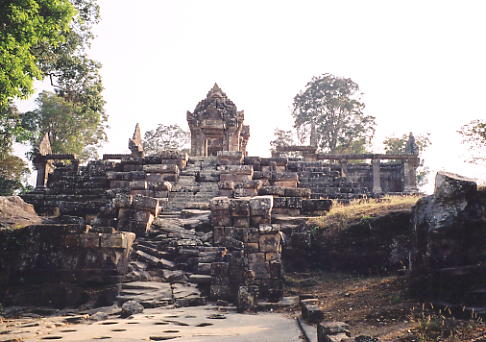 inner tube. Half an hour later, we all stopped for a
beef and rice lunch in the village of Sro Am (a sign suggested an
alternate name of Sraem), at a restaurant next to the monument
marking the junction of the road from Anlong Veng. The final leg
of the journey took another forty minutes, as we raced along a
superb highway which skirted the base of the Dangrek mountain
range, arriving at the village of Kor Mouy at 2pm. I paid for an
admission ticket to the temple, costing 10,000 riel, as we parked
our moto at one of the shops and waited for Beth and Scott to
catch-up. The quickest route up to the temple is by 4WD, though
the two-way trip costs a hefty foreigner price of $20. Its not
feasible to take a moto up the steep track and walking would take
at least a couple of hours, so we agreed to share the cost
between us and we left at 2.30pm. I sat inside the cab, whilst
the others sat in the back and we were all grateful for the skill
of the driver in negotiating the road to the top as at times it
seemed simply too steep to achieve. The fifteen minute ride was
certainly an experience.
inner tube. Half an hour later, we all stopped for a
beef and rice lunch in the village of Sro Am (a sign suggested an
alternate name of Sraem), at a restaurant next to the monument
marking the junction of the road from Anlong Veng. The final leg
of the journey took another forty minutes, as we raced along a
superb highway which skirted the base of the Dangrek mountain
range, arriving at the village of Kor Mouy at 2pm. I paid for an
admission ticket to the temple, costing 10,000 riel, as we parked
our moto at one of the shops and waited for Beth and Scott to
catch-up. The quickest route up to the temple is by 4WD, though
the two-way trip costs a hefty foreigner price of $20. Its not
feasible to take a moto up the steep track and walking would take
at least a couple of hours, so we agreed to share the cost
between us and we left at 2.30pm. I sat inside the cab, whilst
the others sat in the back and we were all grateful for the skill
of the driver in negotiating the road to the top as at times it
seemed simply too steep to achieve. The fifteen minute ride was
certainly an experience.
We
arrived at the first gopura, technically called Gopura V, with
the Cambodian flag flying proudly over a temple which has been
fought for and argued over for a lifetime. In 1962, an
International Court ordered that the temple belonged to Cambodia,
but in subsequent years its ownership has changed hands many
times, particularly during the civil war when  the Khmer Rouge and the Cambodian army took turns in
wrestling control from each other. Today, Cambodia benefits from
the many visitors, though by far the vast majority come from its
Thai neighbours, who are allowed special permission to cross the
border to visit the temple before returning. Our first task was
to find a room for the night, so we walked down the main stairway
to the small market village just inside the Cambodian border and
eventually found a 'room' which was actually a large shelf with a
curtain, in a guesthouse that didn't really deserve the
description. The word basic is a little too generous, but it
still cost Sokhom and myself 10,000 riel for the pleasure! Beth
and Scott took the room next to us, which had a door and
cardboard walls; the height of luxury. Returning to the first
gopura, I wasn't surprised to see the numbers of Thai tourists,
but it was very different from my previous visit in 2002 when the
border was closed and I had the whole temple to myself. For the
next three hours, Sokhom and I wandered
the Khmer Rouge and the Cambodian army took turns in
wrestling control from each other. Today, Cambodia benefits from
the many visitors, though by far the vast majority come from its
Thai neighbours, who are allowed special permission to cross the
border to visit the temple before returning. Our first task was
to find a room for the night, so we walked down the main stairway
to the small market village just inside the Cambodian border and
eventually found a 'room' which was actually a large shelf with a
curtain, in a guesthouse that didn't really deserve the
description. The word basic is a little too generous, but it
still cost Sokhom and myself 10,000 riel for the pleasure! Beth
and Scott took the room next to us, which had a door and
cardboard walls; the height of luxury. Returning to the first
gopura, I wasn't surprised to see the numbers of Thai tourists,
but it was very different from my previous visit in 2002 when the
border was closed and I had the whole temple to myself. For the
next three hours, Sokhom and I wandered  around the five main gopuras of the temple and the
partly collapsed main sanctuary, admiring the wealth of
decorative detail on the lintels and pediments in situ, of which
a remarkable number remain considering the strife heaped upon the
temple in the last thirty years. The location, quite literally on
the edge of the mountain that overlooks northern Cambodia, has
breathtaking views and at 5.45pm, as the sun set across the misty
plains some 500 metres below, we sat on the boulders that mark
the cliff-edge and under a full moon, absorbed the solitude and
stillness, on top of the world. Returning in the dark to our
guesthouse 'room' at 6.30pm, after a cold shower, the foodstall
had almost run out of food as a few travellers were staying that
night and we had to make do with some pork scraps and dried fish,
as we sat in the open courtyard alongwith the scavenging dogs for
company. We walked around the village, pushed our heads into the
karaoke and pool rooms and wandered up to the border post before
retiring to our 'shelf' just after 9pm. A little earlier, I'd
bumped into a good friend of mine, Paul Hay, who was visiting
with a small group of motorbikers and who'd grabbed the best
rooms in the village, owned by the local police chief.
around the five main gopuras of the temple and the
partly collapsed main sanctuary, admiring the wealth of
decorative detail on the lintels and pediments in situ, of which
a remarkable number remain considering the strife heaped upon the
temple in the last thirty years. The location, quite literally on
the edge of the mountain that overlooks northern Cambodia, has
breathtaking views and at 5.45pm, as the sun set across the misty
plains some 500 metres below, we sat on the boulders that mark
the cliff-edge and under a full moon, absorbed the solitude and
stillness, on top of the world. Returning in the dark to our
guesthouse 'room' at 6.30pm, after a cold shower, the foodstall
had almost run out of food as a few travellers were staying that
night and we had to make do with some pork scraps and dried fish,
as we sat in the open courtyard alongwith the scavenging dogs for
company. We walked around the village, pushed our heads into the
karaoke and pool rooms and wandered up to the border post before
retiring to our 'shelf' just after 9pm. A little earlier, I'd
bumped into a good friend of mine, Paul Hay, who was visiting
with a small group of motorbikers and who'd grabbed the best
rooms in the village, owned by the local police chief.
Without
a blanket, my sleep was intermittent between shivering from the
cold and the noise of a rat gnawing away on the other side of the
cardboard wall before finally getting up at 5.30am. Alongwith
Beth and Scott, I 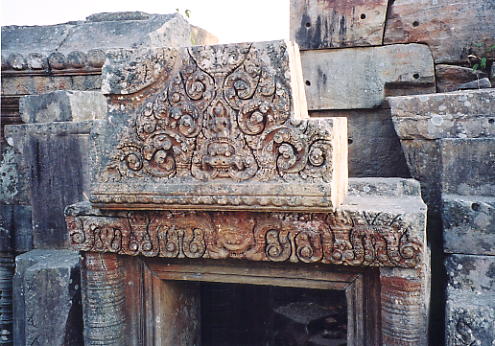 walked up the stairway and through the whole
complex, nearly a kilometre in length, in the semi-darkness, to
return to my cliff-edge seat to wait for the sunrise. It finally
broke through the haze around 6.15am, much to our joint delight,
as smoke from early morning fires on the plains below drifted
skywards and a few of the temple vendors arrived to set up their
wares. The early morning sun threw a beautiful warm yellow glow
onto the lintels and carvings on the eastern side of the temple,
as we made our way back through the complex. 'Danger!! Mines!!'
signs were much in evidence, with a Halo Trust team still
demining parts of the area. The massive nagas at the top of the
main staircase looked
walked up the stairway and through the whole
complex, nearly a kilometre in length, in the semi-darkness, to
return to my cliff-edge seat to wait for the sunrise. It finally
broke through the haze around 6.15am, much to our joint delight,
as smoke from early morning fires on the plains below drifted
skywards and a few of the temple vendors arrived to set up their
wares. The early morning sun threw a beautiful warm yellow glow
onto the lintels and carvings on the eastern side of the temple,
as we made our way back through the complex. 'Danger!! Mines!!'
signs were much in evidence, with a Halo Trust team still
demining parts of the area. The massive nagas at the top of the
main staircase looked 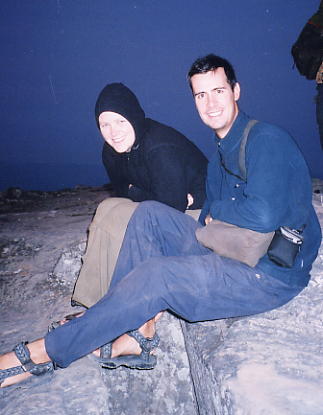 particularly impressive in the early light, as we
descended the 162 steps to the village below, where we had coffee
at the foodstall with Sokhom and Paul Hay. By 8am, we were back
at the first gopura waiting for our 4WD driver to return to
collect us and twenty minutes later we were on our way down the
mountainside. As we descended, we had to avoid the workers laying
a new road that will improve the bumpy ride we endured, whilst
marvelling at our drivers' ability to keep the truck upright on
the testing surface. At Kor Mouy, as I parted company with Beth
and Scott, wishing them well on their travels, a loud explosion
behind the village indicated a controlled mine detonation by the
Halo team. At 9am, we were on the road again retracing our steps
via Sro Am and a long stretch of uninhabited and often rough
road, eventually reaching Thnal Bek three and a half hours later.
We stopped for lunch, beef and rice, and I was a little surprised
to see fried spiders on the cooking stove but declined the cook's
invitation to sample them.
particularly impressive in the early light, as we
descended the 162 steps to the village below, where we had coffee
at the foodstall with Sokhom and Paul Hay. By 8am, we were back
at the first gopura waiting for our 4WD driver to return to
collect us and twenty minutes later we were on our way down the
mountainside. As we descended, we had to avoid the workers laying
a new road that will improve the bumpy ride we endured, whilst
marvelling at our drivers' ability to keep the truck upright on
the testing surface. At Kor Mouy, as I parted company with Beth
and Scott, wishing them well on their travels, a loud explosion
behind the village indicated a controlled mine detonation by the
Halo team. At 9am, we were on the road again retracing our steps
via Sro Am and a long stretch of uninhabited and often rough
road, eventually reaching Thnal Bek three and a half hours later.
We stopped for lunch, beef and rice, and I was a little surprised
to see fried spiders on the cooking stove but declined the cook's
invitation to sample them.
Forty-five
minutes later we skirted around Tbeng Meanchey with Sokhom
determined to get us back to Kompong Thom that same day. The road
from Tbeng Meanchey is now very familiar, so it was noticeable
that 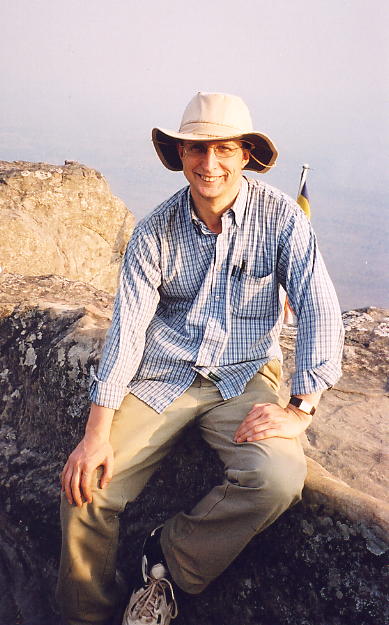 more houses have sprung up along the roadside,
considerably more trees have been felled and everywhere, small
fires were burning off old rice stalks and undergrowth. We passed
a new sign for a temple called Prasat Preah Lean near the village
of Preah Khleang but didn't have time to investigate, reaching
Phnom Dek at 4pm, where we called into see our favourite petrol
attendant, who had a beaming smile as always. As darkness fell,
we eventually reached Kompong Thom at 7.30pm, the last 20kms made
a lot trickier by the Khmer habit of walking on the highway in
pitch darkness without letting fellow road users know you're
there! Having been on the road for ten hours, I booked into the
Mittapheap hotel and two hot showers managed to get most of the
grime off me, as I crossed the bridge to try out the Stung Sen
restaurant for the first time. Once known as the best place in
town, its now very run down and the two effeminate waiters
offered me a lot more than my fried rice and chicken, which I
politely declined, and walked to Sokhom's home where I met up
with our mutual friend, Caroline Nixon, who was in town for one
night only. We had tikaloks and talked until I left Sokhom's a
little before 10pm to return to the hotel, at the end of a tiring
but very satisfying trip.
more houses have sprung up along the roadside,
considerably more trees have been felled and everywhere, small
fires were burning off old rice stalks and undergrowth. We passed
a new sign for a temple called Prasat Preah Lean near the village
of Preah Khleang but didn't have time to investigate, reaching
Phnom Dek at 4pm, where we called into see our favourite petrol
attendant, who had a beaming smile as always. As darkness fell,
we eventually reached Kompong Thom at 7.30pm, the last 20kms made
a lot trickier by the Khmer habit of walking on the highway in
pitch darkness without letting fellow road users know you're
there! Having been on the road for ten hours, I booked into the
Mittapheap hotel and two hot showers managed to get most of the
grime off me, as I crossed the bridge to try out the Stung Sen
restaurant for the first time. Once known as the best place in
town, its now very run down and the two effeminate waiters
offered me a lot more than my fried rice and chicken, which I
politely declined, and walked to Sokhom's home where I met up
with our mutual friend, Caroline Nixon, who was in town for one
night only. We had tikaloks and talked until I left Sokhom's a
little before 10pm to return to the hotel, at the end of a tiring
but very satisfying trip.
Here's links to the rest of my Cambodia Tales
January 2005 marked my eleventh trip to Cambodia since my first-ever visit in 1994. It's a country that has a special magic all of its own and which draws me back every year to venture out into the Cambodian countryside in search of new adventures, ancient temples and to catch up with the friends I've made from previous visits. Each trip is full of laughter, smiles and a host of fresh experiences and my latest expedition was no exception.
Home : Next : Messageboard : 2005 : E-mail
The contents of this website cannot be reproduced or copied without permission of the site author. (c) Andy Brouwer 2005
Click to enlarge all photos. Click 'refresh' if photos do not fully load.